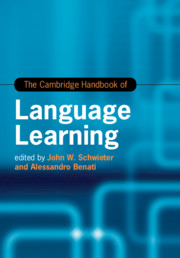Book contents
- The Cambridge Handbook of Language Learning
- Cambridge Handbooks in Language and Linguistics
- The Cambridge Handbook of Language Learning
- Copyright page
- Contents
- Figures
- Tables
- Contributors
- Acknowledgements
- Introduction
- Part I Theories
- Part II Methods
- Part III Skill Development
- Part IV Individual Differences
- 15 Working Memory in L2 Learning and Processing
- 16 Language Aptitudes in L2 Acquisition
- 17 Language Learner Motivation: What Motivates Motivation Researchers?
- 18 A New Look at “Age”: Young and Old L2 Learners
- 19 Identity
- Part V Pedagogical Interventions and Approaches
- Part VI Context and Environment
- Part VII Moving Forward
- Index
- References
16 - Language Aptitudes in L2 Acquisition
from Part IV - Individual Differences
Published online by Cambridge University Press: 25 June 2019
- The Cambridge Handbook of Language Learning
- Cambridge Handbooks in Language and Linguistics
- The Cambridge Handbook of Language Learning
- Copyright page
- Contents
- Figures
- Tables
- Contributors
- Acknowledgements
- Introduction
- Part I Theories
- Part II Methods
- Part III Skill Development
- Part IV Individual Differences
- 15 Working Memory in L2 Learning and Processing
- 16 Language Aptitudes in L2 Acquisition
- 17 Language Learner Motivation: What Motivates Motivation Researchers?
- 18 A New Look at “Age”: Young and Old L2 Learners
- 19 Identity
- Part V Pedagogical Interventions and Approaches
- Part VI Context and Environment
- Part VII Moving Forward
- Index
- References
Summary
Some adults learn a second language (L2) more rapidly and/or to a higher level of proficiency than others. One of the factors that can explain such individual differences (IDs) in rate of acquisition and/or ultimate attainment is language aptitude, defined as a combination of cognitive and perceptual abilities that are advantageous in second language acquisition (SLA; Carroll, 1981; Doughty et al., 2010). This chapter provides a state-of-the-field overview of language aptitude research in SLA. A blend of theory and empirical work on this area, the chapter offers an approach to understanding and measuring aptitude components and functions in L2 learning. Starting with a review of the past and present of the construct, with a special emphasis on recent advances, the chapter moves on to a discussion of its predictive validity in naturalistic and instructed SLA and ends with a look into the future by analysing the implications of aptitude research for L2 instruction.
- Type
- Chapter
- Information
- The Cambridge Handbook of Language Learning , pp. 390 - 408Publisher: Cambridge University PressPrint publication year: 2019
References
- 2
- Cited by



